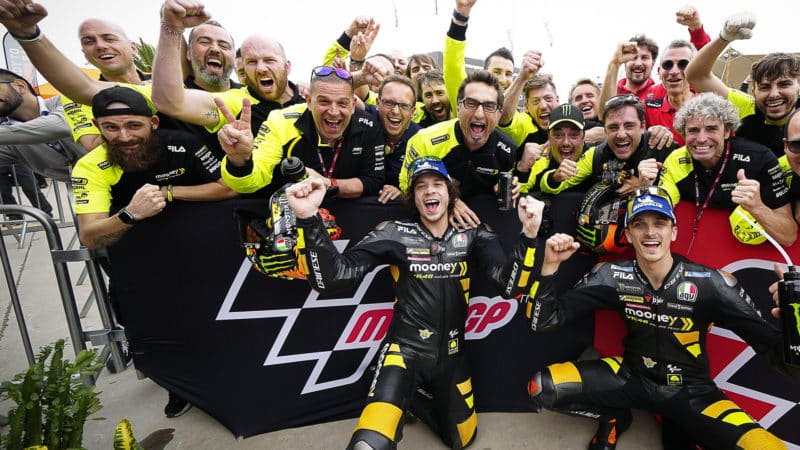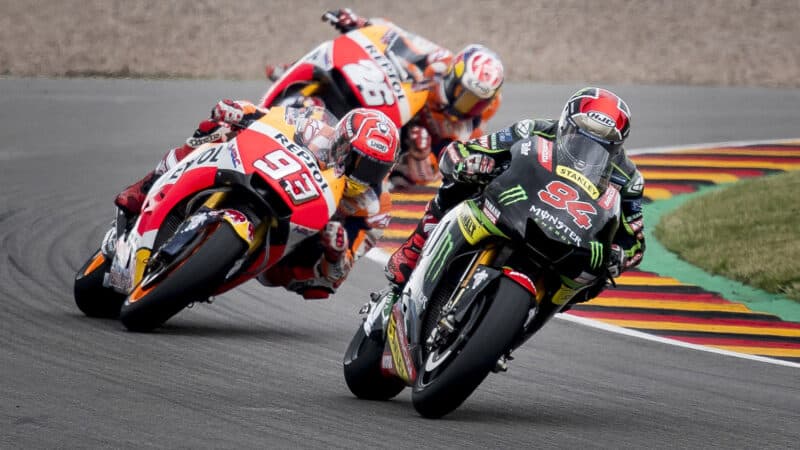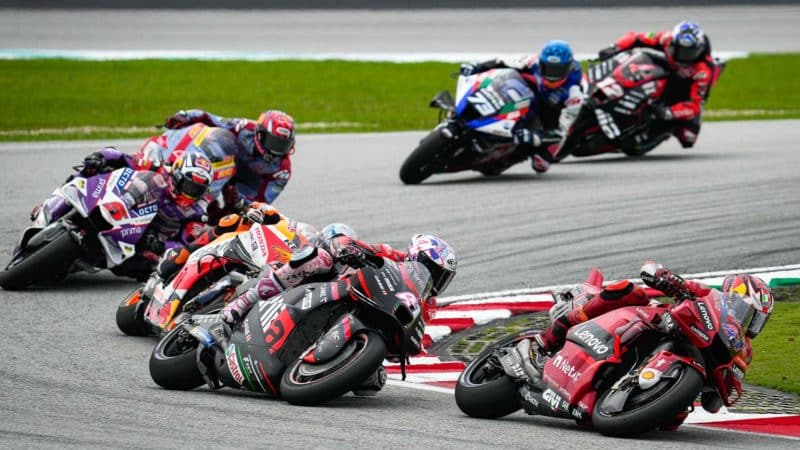MotoGP: The best of Mat Oxley from 2023
The best of MotoGP reporting in 2023 from Mat Oxley

Martin leads Bagnaia at Sachsenring – it was the first time the Spaniard beat the Italian in a straight fight this year and really started his title campaign
Red Bull
Any fears that Pecco Bagnaia would have it all his own way after Ducati team-mate Enea Bastianini had to sit out much of the season with injuries were quashed as Jorge Martin challenged the reigning champion in 2023 — and took the championship to the wire.
Bagnaia did prevail, but likely to face an even tougher challenge in 2024 if Martin and Bastianini remain uninjured — along with Marc Márquez who moves from an underperforming Honda to Ducati.
Unsurprisingly, the rumours and eventual confirmation of the eight-time world champion’s new contract stole many of the headlines in 2023, as did the continuing shambles around tyre pressures, resulting in both championship contenders under threat of a time penalty as the season drew to a conclusion.
Mat Oxley has led coverage of that story from the start and continued to cover the seismic effect that the poorly drafted rules are likely to have. However, in choosing his favourite stories of the year, Mat has selected columns that are less deflating: from his hair-raising experience in the Le Mans campsites to a rollicking tribute to Mike Trimby, as well as the man behind some of Ducati’s ground-breaking tech, don’t miss some of the finest motorcycle racing writing from 2023.
Le Mans MotoGP – a petrolhead Glastonbury
Last weekend’s French MotoGP round attracted 278,000 fans. Some go for the racing, others for the campsite mayhem. So how mad is the campsite and is this a lesson for MotoGP?

Two motorcycles in the Le Mans campsite, one dead, the other dying. Lots of vans too – in which to sleep and also to take home your dead motorcycle
Mat Oxley
May 17
Eyes blinded by smoke, faces crispened by flames, ears deafened by the chatter of small-arms fire and the boom-boom of artillery, we keep moving forward, undaunted, towards our target, which must be reached, at all costs.
A man goes down in front of us, face in the dust, gurgling uncontrollably. Ambulances screech past, sirens wailing, blue lights flashing, rushing more casualties to the medical station at the rear.
War is hell, they say. But this is war without the shooting. The man who went down gurgling, now rolls onto his back, face smeared with dust and beer, giggling uncontrollably. Until he realises it’s his beer that’s been spilt.
My comrades in this adventure are locals Kevin and Ophélie, who have been partaking in this lunacy for years. And they’re laughing too. All around is insanity, beautiful insanity.
Welcome to the MotoGP campsite at Le Mans, which stretches as far as you can see in all directions like a vast warzone: flames erupting here and there, while palls of black, oily smoke hang over the scene as the sun goes down, ushering in the night, when the real crazies come out to play.
Under cover of darkness the place goes completement gaga – like an illegal rave in the countryside, except the crazies aren’t gyrating to a trance beat, they’re jumping up and down to the pop-pop-pop of engines that can’t be far from death.
How skyscrapers made Ducati’s Desmosedici fly!
Three of Ducati’s game-changing MotoGP technologies were created by an engineering genius you’ve probably never heard of…

Tuluie and some skyscrapers, which helped him create a vital new gadget that helped transform Ducati from MotoGP loser to winner
Chippy Wood
April 4
German-born astrophysicist and former motorcycle racer Robin Tuluie has worked with Gigi Dall’Igna on Ducati’s MotoGP project since 2016. Tuluie is sworn to secrecy about his role at Borgo Panigale, but I can give you a good idea of what he does there by telling you what he did when he was with his previous two employees, the Renault and Mercedes Formula 1 teams.
At Renault, Tuluie and his team created the first tuned mass damper used in motor racing, which helped Fernando Alonso win the 2005 F1 title. A few years later at Mercedes, Tulie and his team created a hydraulic ride-height regulator that took Lewis Hamilton to the 2014 F1 crown. At Mercedes his job title was about as cool as it gets: chief scientist.
Both these technologies were subsequently banned from F1, simply because they gave such a huge advantage.
After working his magic at Mercedes, Tuluie became Director of Vehicle Technology at Bentley and also started working at Ducati, because both the British luxury car brand and the Italian motorcycle manufacturer are owned by the same company, the VW Group, which also owns Audi and Porsche.
Ducati dominates MotoGP for many reasons, including these three game-changing technologies: the Desmosedici’s tuned mass damper, which damps out chatter and suspension pump, as well as its hydraulic ride-height device and its hydraulically activated holeshot device, which both reduce wheelies to increase acceleration.
Is that a good enough clue for you?
‘Bellissimo!’: Rossi’s right-hand man reveals how VR46 team is ruling MotoGP
Valentino Rossi’s VR46 MotoGP team and Riders Academy are ruling MotoGP – holding the top two places in the championship and winning two of 2023’s first three races. Team director Uccio Salucci tells Mat Oxley how they do it

The VR46 team after the Argentine sprint race – they are a close-knit, hard-working, hard-playing bunch
VR46
April 18
People often say that Valentino Rossi’s life unfolds like a Hollywood movie: from one unlikely scene to another, plenty of romance and a plot twist around every corner.
And now the next scene is unfolding before our very eyes: Rossi has retired from MotoGP but the team he created is now winning races, making headlines and dominating the paddock’s consciousness.
Marco Bezzecchi won the rain-soaked Argentine MotoGP race earlier this month, Rossi’s half-brother Luca Marini finished a close second in Sunday’s Grand Prix of the Americas and Bezzecchi leads the world championship, on a second-hand Ducati Desmosedici, ahead of another VR46 Academy rider, Pecco Bagnaia.
Only a fever-brained Hollywood scriptwriter would consider such a storyline – and then he’d bin it, sure that no one would believe it…
‘MotoGP bikes aren’t easier to ride now, they’re harder to ride’
Jonas Folger made a brilliant start to his MotoGP career in 2017, then got ill. He returned this season, subbing for the injured Pol Espargaró, so there’s no one better to ask the question: how exactly have MotoGP bikes changed in the last few years?

Before downforce aero and devices – Folger leads the 2017 German GP, chased by Marc Márquez and Dani Pedrosa
Tech 3
July 4
Everyone knows that MotoGP has changed massively in recent seasons, with the arrival of all kinds of new technologies: holeshot devices, ride-height devices, mass dampers and most of all downforce aerodynamics.
These have totally transformed the motorcycles, transformed the racing and transformed the way riders ride, because MotoGP bikes are no longer like normal motorcycles, just like Formula 1 cars aren’t like normal cars.
Most MotoGP riders have been on the grid throughout these years of great change, getting used to each new technology, step by step. But there’s one rider who has the perfect view of how everything has changed: 29-year-old German Jonas Folger.
Mike Trimby: The man who made MotoGP
When you sit down to watch a MotoGP race you need to thank one man more than anyone else for the show: Mike Trimby

Jack Miller, Aleix Espargaró, Marc Márquez (out injured for six races), Johann Zarco and others have had very up and down 2022s
Dorna Sports
September 9
Former racer Mike Trimby has worked in the MotoGP paddock since the early 1980s and is largely responsible for the four cornerstones of the spectacle that we all know and love: improving circuit safety, putting the races on TV, organising the teams and making sure everyone gets paid.
Trimby started out as a revolutionary – going after the cigar-chomping, blazer-wearing racing establishment who treated the riders like performing animals. The first battles he fought was for better safety, better paddock conditions and better money.
“The old promoters and the FIM treated us like shit,” recalls ‘King’ Kenny Roberts, a 500cc GP winner from 1978 to 1983. “It was just wrong, they had us by the balls. Some of the tracks were so dangerous it was stupid. And you’d have to tickle the promoters’ balls to get500 bucks more. The whole thing was like a mafia deal.”
In 1982 Roberts, Barry Sheene, Franco Uncini and other top riders hired Trimby to fight for their rights, because they were too busy racing to waste time arguing with the old-boys network of the FIM (the Fédération Internationale de Motocyclisme, the sport’s governing body) and the promoters.
The priorities of the old crooks running the show was to keep prize money low and spend nothing on the circuits. If riders died, so be it. “The throttle works both ways,” was their mantra. In other words, if you die it’s your fault, not ours.

